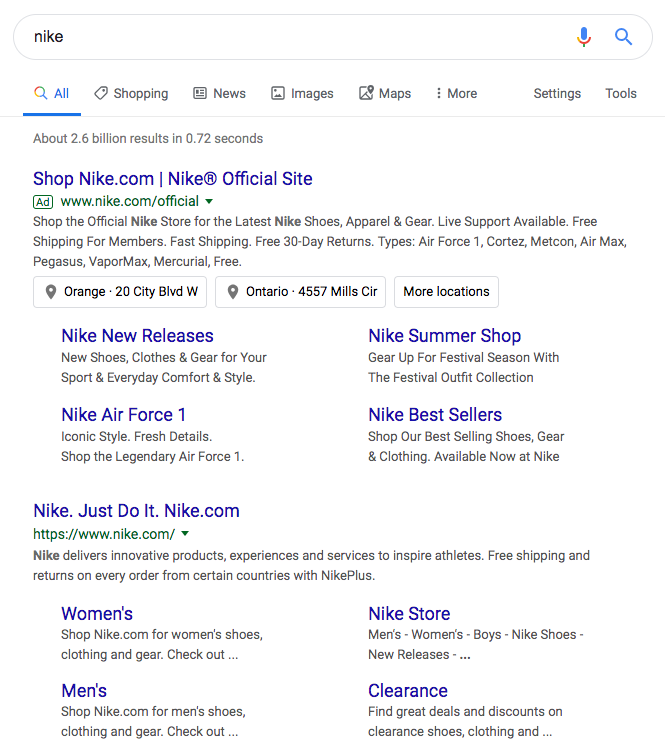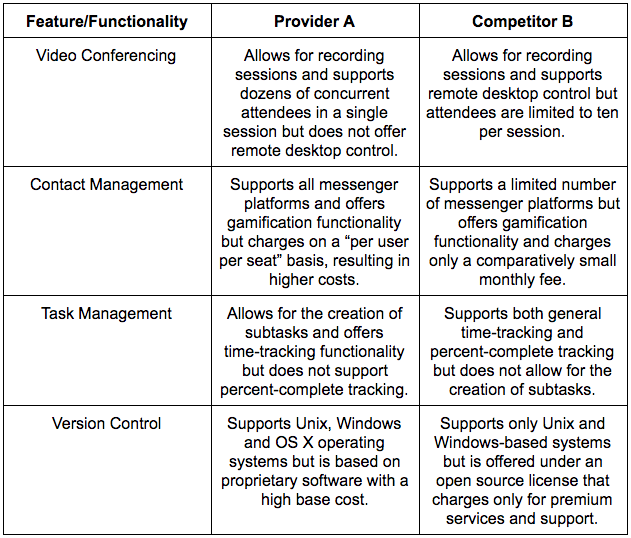One of the biggest advantages of running a paid search campaign is the ability to bid on keywords that would be difficult (if not impossible) for your website to rank for organically.
The best example of this is bidding on competitors’ brand or product names. For example, if you’re in the athletic shoe/apparel industry, you’d probably want to bid on Nike or UnderArmour branded terms. So, if you’re not running any competitor focused campaigns right now, you are definitely missing out.

But it doesn’t have to be that way. Here are five steps to set up and run a successful competitor-focused SEM campaign.
Step one: Do your research
First things first, you’ll want to go through a current list of competitors and perform preliminary keyword research on each of them, one-by-one.
Preliminary research should cover average monthly search volume, the number of relevant keyword variations, estimated keyword bids, and any potential conflicts or double-meanings – a classic example would be “Apple” the company or “apple” the fruit) within the keyword phrases you are considering targeting. This should include not only the competitors’ brand names but also all product name(s) that your company competes with directly. You’ll want to repeat this step for every competitor on the list.
Step two: Choose your competitors wisely
After going through the research portion mentioned in step one you’ll want to narrow down your list and focus on just your top three competitors. Why only three? To ensure your messaging is tightly focused around each competitor and that your key differentiators against each specific product can be clearly communicated in both the ad copy and on a custom landing page (more on landing pages in a minute). So how do you determine which three competitors to focus on?
After completing step one you should have the quantitative data needed to determine if it’s worth targeting certain keywords related to a specific competitor or product. But don’t just go off of the numbers alone. You’ll also want to account for strategic business reasons that could outweigh factors such as monthly search volume or estimated bid numbers. For example, your company is planning to launch a new product in the coming months and wants to hit the ground running.
If everything still looks good at this point then you can continue with your standard keyword research/selection process. But be sure to keep the following in mind:
- Use exact match if a brand or product name has an abnormally high average monthly search volume.
- Include all relevant brand/product name variations as well as common misspellings.
- Pay close attention to the following queries – “alternative to [your competitor]”, “[your company name] competitors”, or “[your competitor #1] vs [your competitor #2]”. You’ll likely want to include these phrases in your campaign.
Step three: Landing pages (the bread and butter)
Let’s face it, landing pages are your workhorse. They can make or break your campaign. Because of this, I always recommend creating a unique landing page for each competitor. You may be thinking, that’s going to take a lot more time, is it really worth it?
The answer is yes and the reasons are simple, relevance and context. Relevance is important because you’re going to be bidding on keywords with the intention of “stealing” traffic away from your competitors. And context is critical because if the prospect’s intention was to find out more about one of your competitors, you are steering them off their original course. This is fine but you need to make it clear how you’re adding value to their research efforts.
With this in mind, let’s go over a few specific recommendations when it comes to creating engaging competitor-focused landing pages.
First, it’s important to immediately convey that the content is all about “You vs. Specific Competitor X”. Since people are going to be actively searching for information on Competitor X, you’ll not only want to show them the info they’re most likely looking for but also how your company stacks up against said info. So, for example, by creating a basic three column table with the first column listing out the features/functions, the second showing how your company performs against that feature/function and the third how your competitor stacks up. It’s an easy, visual way to convey the focus of the page and provide the visitor with the information they were probably searching for in the first place.

Ideally, you want to make sure the content is designed to give the visitor a fair comparison of you and your specific target competitor. This is particularly true for certain queries such as, “alternative to [your competitor]”.
Step four: A/B testing from the get-go
Marketers are constantly told that they need to be doing more A/B testing. But is this overkill? Yes and no. You definitely want to be following the ABT (Always Be Testing) rule when it comes to running any digital campaign. But too much testing can eat up time and resources that could be spent on other campaigns or initiatives.
So, to help mitigate, you’ll want to take steps to streamline testing right off the bat. For example, don’t use your competitor’s name directly in the ad copy itself. Depending on your industry and level of competition this might not be an issue (local “mom & pop shops” probably haven’t trademarked their business name). However, for any decent size company, you’ll have to assume their name will be trademarked, which means your ad will get rejected for using a trademarked term. To save time it’s best to avoid using brand names in your copy.
The testing in your ad copy should focus on testing different key differentiators in relation to a specific competitor. The reason for this is simple, you won’t be able to include every single differentiator in your copy due to character count restrictions. So instead you have to focus on the most compelling ones.
Note: These differentiators should be included on the corresponding landing page as well.
Lastly, when running this kind of A/B test you’ll want to make sure to change only one element at a time. If you’re changing more than one element at a time it can be difficult to determine the true cause of any fluctuation in performance. For example, if you change headline one in an ad, you’ll want to keep description one and the CTA consistent.
Step five: Quality over quantity
Last but definitely not least, let’s talk about leads, you know, the reason we’re all running these campaigns in the first place.
Too many companies focus on the wrong thing when it comes to leads – Raw numbers. What companies really need to focus on is quality. Revolutionary, I know. But how can you assess quality?
First, start by looking at the following information – Was a work email provided? Did the prospect provide their title? If so, does it fall in line with your target audience? Does their company match your target company revenue/size/industry targets?
The answers to these questions will tell you if your campaign is on the right track, or if adjustments need to be made. They will also provide valuable context, something the raw number of new prospects generated won’t be able to.
With that said, there is still value in continuing to track and report on both, the total number of new prospects (which is quantity) as well as the number of designated “ideal fit” prospects (which is quality). Taken together, these metrics will help you to determine how successful your campaign has been.
Running a successful competitor focused paid search campaign can be tough. From the setup to the ongoing optimization and the reporting, it’s non-stop data gathering, analysis, copywriting, and A/B testing. But if you follow these five steps, it should help to streamline the process and make it easier to manage.
The post How to run a successful competitor-focused paid campaign appeared first on Search Engine Watch.
from SEO – Search Engine Watch https://ift.tt/2LkPaUO
via IFTTT

No comments:
Post a Comment